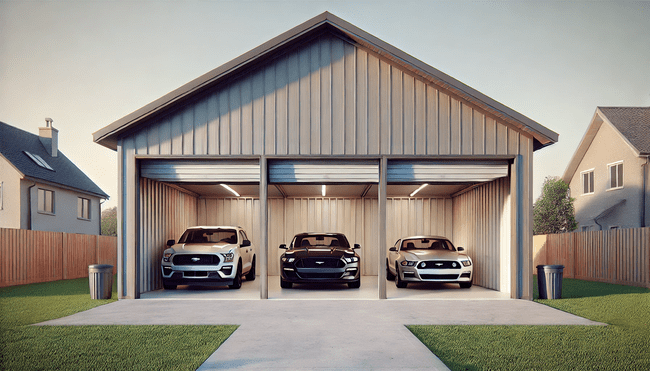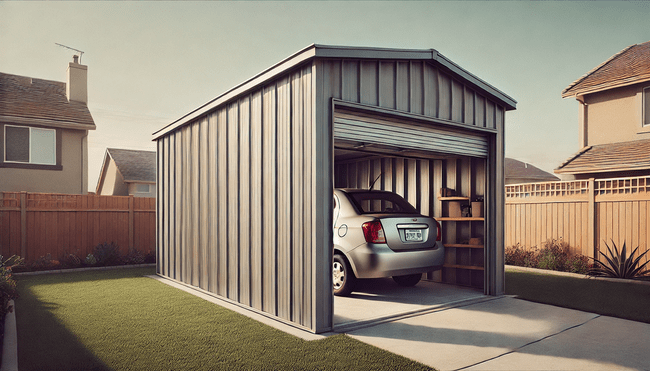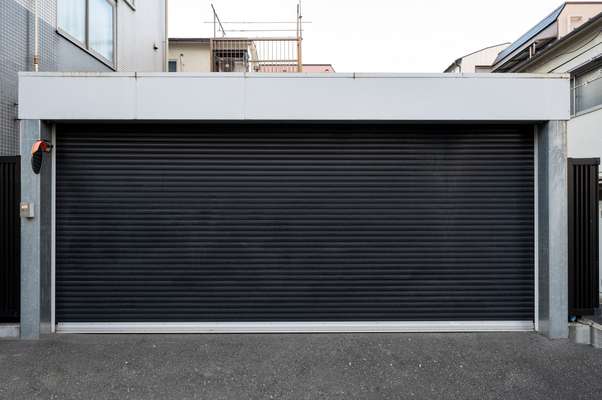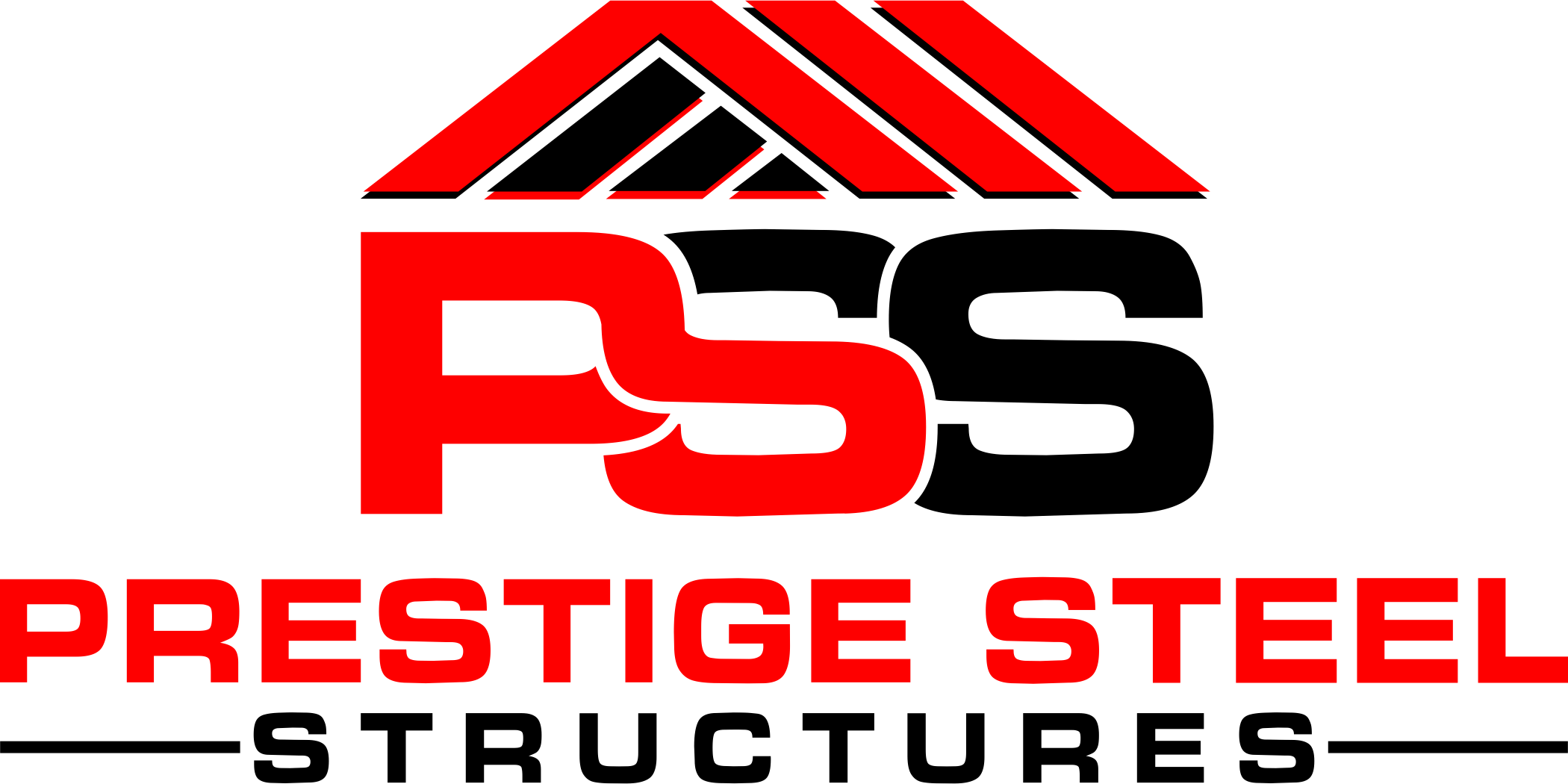When it comes to enhancing your property’s functionality and securing your valuable assets, few investments match the versatility and durability of a metal garage. Whether you’re a homeowner wanting to protect your vehicles from the elements, an enthusiast needing a dedicated workspace, or a business owner requiring extra storage, adding a metal garage to your property is a smart choice.
It’s a significant project, and one critical factor can make or break your investment: selecting the right size. The right dimensions ensure that your new garage meets all your needs without wasting space or resources. Careful planning is essential to achieve the perfect balance between functionality and cost-effectiveness.
Our professional metal building installation experts are here to guide you through determining the ideal dimensions for your new steel structure. They will share valuable insights and tips to ensure you choose the perfect size, maximizing both functionality and value for your property.

Factors Affecting Metal Garage Size Choice
When you’re choosing the perfect size for your steel building, it’s important to look beyond just the basic dimensions and immediate requirements. Delving into the specifics can significantly enhance the functionality and success of your metal garage. Taking the time to understand the unique factors that impact your choice will ensure that your building not only meets but exceeds your expectations.
By considering more than just standard size options, you set the stage for a steel building that is tailored to your precise needs. This proactive approach helps in creating a space that is not only practical but also adaptable to future requirements. Make sure to give thoughtful consideration to all influencing elements to make the most out of your investment in a steel structure.
Interior Height Requirements
If you’re looking to house tall vehicles or equipment in your metal garage, the interior height is an essential factor to consider. For those planning to park an RV or other high-reaching vehicles, ensuring adequate vertical clearance is key. Before making a decision, measure the height of your RV or any tall equipment to confirm that the garage you choose offers enough space to fit everything comfortably.
Moreover, if you’re considering adding overhead storage racks or setting up elevated workspaces, the ceiling height of your garage should not be overlooked. Take the time to assess your needs for vertical space and plan accordingly, ensuring that the interior height of your garage supports all your functional and storage requirements effectively.
Weather and Climate Factors
The local climate is a crucial factor when deciding on the size and design of your steel building. If you live in a region prone to heavy snowfall, it’s essential to consider the snow’s weight on your garage roof—choose a roof design and size robust enough to support the expected snow load without risking structural integrity. Similarly, in areas where high winds are common, opting for a sturdier construction will ensure your building can stand up to the wind forces, keeping your investments safe and secure.
Budget Considerations and Cost Factors
When planning the size of your metal garage, it’s vital to keep your budget in mind. Larger structures not only demand more materials and labor but also bring potential extra costs such as permits and site preparation. This makes it crucial to realistically evaluate what you can afford before making any decisions.
Take the time to compare how different sizes of metal buildings fit within your budget constraints. Understanding the cost implications of various dimensions can help you make an informed choice that aligns with both your needs and your financial capacity, ensuring that you invest wisely in your new structure.
Accessibility Needs
Ensuring that your metal building is easily accessible is key to its functionality. It’s important to choose garage doors that are proportionate to the vehicles or equipment you intend to store. Make sure the doors are sufficiently wide and tall to allow for hassle-free entry and exit. This consideration is not just about size, but also about making your daily operations smoother and more efficient.
Additionally, the positioning of these doors is critical. Reflect on the way you’ll move vehicles or equipment into and out of the building. The placement of the doors should harmonize with your property’s layout and existing access routes. Thoughtful door placement enhances the practicality of your steel building, ensuring that it complements the flow of your space effectively.

Assessing Your Steel Building Requirements
Before diving into the selection of your ideal metal building size, it’s crucial to take a step back and thoroughly assess your specific needs and goals for your property. Understanding these unique requirements is the key to making an informed decision that ensures your metal garage not only meets but excels in its intended purpose, providing you with an effective and efficient solution tailored to your situation.
Measure the Space Available for Your Metal Garage
A vital step in choosing the right size for your metal building is accurately measuring your property’s square footage. Along with this, it’s important to have a solid grasp of local building regulations and any site-specific challenges that could affect the installation. Ensuring you have this information upfront will help facilitate a smooth and compliant setup of your new metal structure, aligning perfectly with your needs and local requirements.
Take Into Account Local Building Codes, Zoning Laws, and Setbacks
Before you set the size and pinpoint the placement of your metal garage, it’s crucial to become well-acquainted with the local building codes, zoning regulations, and setback requirements that apply to steel buildings in your area. These rules differ widely depending on your location and can significantly influence both the positioning and the construction of your garage. Dive into the local building codes to grasp the essentials about structural integrity, safety norms, and acceptable materials.
Additionally, understanding the zoning laws is key, as these regulations determine the types of structures allowed in various parts of your community. Make sure your chosen spot aligns with these legal stipulations. Moreover, familiarize yourself with setback rules set by local authorities, which mandate specific distances that buildings must maintain from property boundaries, roads, and other structures. Compliance with these setback requirements is not just about following the law—it’s about ensuring your project proceeds without any hitches.
Assess What Will Be Stored or Parked in the Garage
Before deciding on the size of your new metal building, take a detailed inventory of everything you plan to store or any vehicles you intend to park inside. For each vehicle, measure the length, width, and height, and factor in additional space for easy maneuvering and door opening. For stored items such as boxes, furniture, or machinery, assess the size and volume of each piece. Consider whether you’ll need organizational solutions like shelves, racks, or cabinets to optimize the space. This thorough approach ensures you choose a building that meets your minimum space requirements effectively.
Guide to Measuring Space for Metal Buildings
Begin the process of installing your metal garage by accurately measuring the dimensions of the designated area. Start with the length, measuring from the furthest points of the installation site to capture any variations in the terrain. Follow up by assessing the width, ensuring to take multiple measurements at different points to account for any discrepancies in the landscape. Finally, consider the height clearance necessary, particularly if you plan to house larger vehicles or equipment. This meticulous approach to measurement will help guarantee that your metal garage fits perfectly in the intended space.
Determine the Intended Use of Your Metal Garage
The first crucial step in planning your metal garage is identifying its primary use, as this will guide all subsequent decisions regarding its design and size. Whether you’re looking to store garden tools, seasonal items, or equipment, your focus might be on a smaller garage that maximizes space through smart storage solutions. On the other hand, if the garage will serve as a workshop, you’ll need ample space not just for storage but also for accommodating workbenches, tools, and materials for your hobbies or home improvement projects.
If the main function of your garage is to protect vehicles, it’s important to consider how many vehicles you plan to store and their sizes. This assessment will help you determine whether a single-car garage suffices, or if a double-car or even larger garage is necessary. Each scenario requires careful consideration of space to ensure your metal garage fulfills its intended purpose efficiently and effectively.
Identify Any Unique Site Challenges
Every property is unique, with specific features and challenges that can influence the installation of a metal building. Assess the terrain of your land; is it flat, sloped, or irregular? A sloped terrain might necessitate extra groundwork and leveling to prepare the site. It’s also crucial to examine the natural drainage patterns to ensure there’s no water accumulation around or beneath your garage, as proper drainage is vital for the structure’s longevity. Additionally, the type of soil on your property can affect the foundation requirements, so it’s important to discuss this with your installation company to guarantee a solid base. Finally, think about access to the garage. Make sure the location you choose allows for easy and convenient entry and exit, enhancing the functionality and accessibility of your metal garage.

Common Metal Garage Dimensions
When shopping for a metal garage, it’s important to familiarize yourself with the various standard sizes available on the market, designed to meet a broad spectrum of needs and preferences. By gaining a thorough understanding of these options, you can make a well-informed choice that aligns perfectly with the specific requirements of your home and property. This knowledge ensures that you select a garage that not only fits your space but also enhances its functionality and value.
Single-Car Garages
A typical single-car garage spans approximately 12 feet in width and 20 to 24 feet in length, providing ample room to comfortably house one standard-sized vehicle. This compact design is especially advantageous for properties where space is at a premium. Not only is a single-car garage more budget-friendly compared to larger alternatives, but it often simplifies the permitting process, making it a practical choice for many homeowners.
However, the single-car garage does have its limitations. The confined space may not suffice for storing multiple vehicles or meet extensive storage requirements. Additionally, these garages often lack the necessary space to serve as a functional workshop, office, or commercial space, which could be a significant drawback for those needing more versatile or expansive facilities.
Double-Car Garages
Designed to fit two vehicles side by side, a double-car garage typically measures between 20 to 24 feet in both width and length, offering generous space not just for two cars but also for additional storage. This type of garage is highly versatile, easily accommodating a workspace or extra storage needs according to your requirements. However, it’s important to consider that a double-car garage requires a larger footprint on your property and generally comes at a higher cost compared to single-car garages. These factors make it crucial to assess both your space availability and budget before deciding.
Extra-Large Garages
If you need more space than a double-car garage can offer, there are larger options available, such as triple-car garages or even oversized models that can exceed 30 feet in both width and length. These spacious structures are ideal for those who have multiple vehicles or require extensive storage and workspace for various belongings.
The advantages of opting for a larger garage include not just the abundance of space but also the ability to future-proof your property. Whether it’s accommodating more vehicles or additional equipment as your needs grow, a larger garage ensures you’re prepared. Moreover, the versatility of these garages allows them to serve multiple functions, from workshops to recreational spaces, adding significant value to your property.
However, there are some drawbacks to consider. Constructing a larger garage comes with higher costs due to increased materials and labor. They also require more land, which might not be feasible for those with limited property space. Additionally, the process of obtaining permits for larger structures can be more complex and demanding, involving stricter requirements that must be navigated carefully.
Conclusion
Are you considering upgrading your property with a metal garage that perfectly fits your needs? At Prestige Steel Structures, our team of steel building installation experts is dedicated to guiding you through every stage of the process. We’re here to help you assess your specific needs, ensure full compliance with local regulations, and design an efficient layout that maximizes your space. Our commitment is to ensure that your project unfolds smoothly and meets all your expectations.
Ready to take the first step towards a new metal garage that enhances your property? Contact Prestige Steel Structures today to schedule a consultation. Whether you prefer to call us directly or fill out our online contact form, we’re prepared to help you start on your path to a successful and satisfying project.


